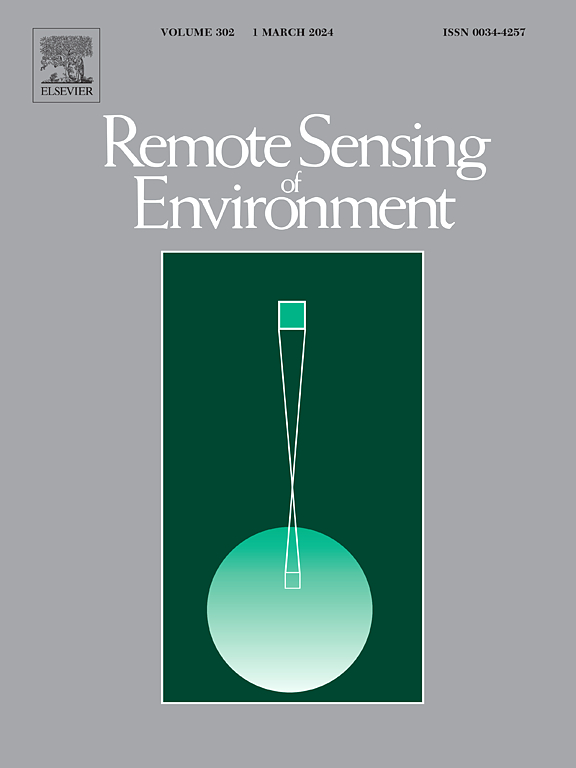Detection of multi-year ex-fast ice in the Weddell Sea, Antarctica, using ICESat-2 satellite altimeter data
IF 11.4
1区 地球科学
Q1 ENVIRONMENTAL SCIENCES
引用次数: 0
Abstract
Landfast ice, sea ice fastened to coastal land or ice shelves, generally undergoes distinctive thermodynamic growth and less active dynamic deformation due to its prolonged attachment to the land, resulting in a thicker and smoother surface compared to drifting pack ice. In 2019, large landfast ice floes were detached from the Ronne Ice Shelf, and the broken pieces started to drift into the Weddell Sea. This study employs a random forest (RF) machine learning model to detect these ex-fast ice floes using six key variables from the ICESat-2 ATL10 sea ice freeboard product: freeboard, Gaussian width of photon height distribution, standard deviation of freeboard, floe length, modal freeboard, and sea ice concentration. The RF model achieves an overall accuracy of 99 % in detecting ex-fast ice, effectively capturing the drift, freeboard distribution, and size distribution of ex-fast ice floes across the western Weddell Sea in 2019. Among six variables, freeboard, standard deviation of freeboard, and Gaussian width of photon height distribution contribute over 94 % to the model performance. Furthermore, the detection of ex-fast ice improves the quantification of sea ice topographical features derived from ICESat-2, including modal freeboard, ridge fraction, and surface roughness. This study highlights the effectiveness of discriminating heterogeneous ex-fast ice from typical pack ice to enhance sea ice measurements using ICESat-2 satellite altimeter data.
利用ICESat-2卫星高度计数据探测南极洲威德尔海多年快速冰
固定在海岸陆地或冰架上的海冰,由于长期附着在陆地上,通常会经历独特的热力学增长和较少活跃的动态变形,因此与漂流的浮冰相比,其表面更厚、更光滑。2019年,大块陆地浮冰从罗纳冰架上分离出来,碎片开始漂流到威德尔海。本研究采用随机森林(RF)机器学习模型,利用ICESat-2 ATL10海冰干舷产品中的六个关键变量:干舷、光子高度分布的高斯宽度、干舷标准差、浮冰长度、模态干舷和海冰浓度来检测这些快速浮冰。RF模型在检测快速浮冰方面的总体精度达到99%,有效捕获了2019年威德尔海西部快速浮冰的漂移、干舷分布和尺寸分布。在6个变量中,干舷、干舷标准差和光子高度分布的高斯宽度对模型性能的影响超过94%。此外,快速冰的探测改善了由ICESat-2获得的海冰地形特征的量化,包括模态干舷、山脊分数和表面粗糙度。本研究强调了利用ICESat-2卫星高度计数据区分非均匀速冰和典型浮冰的有效性,以增强海冰测量。
本文章由计算机程序翻译,如有差异,请以英文原文为准。
求助全文
约1分钟内获得全文
求助全文
来源期刊

Remote Sensing of Environment
环境科学-成像科学与照相技术
CiteScore
25.10
自引率
8.90%
发文量
455
审稿时长
53 days
期刊介绍:
Remote Sensing of Environment (RSE) serves the Earth observation community by disseminating results on the theory, science, applications, and technology that contribute to advancing the field of remote sensing. With a thoroughly interdisciplinary approach, RSE encompasses terrestrial, oceanic, and atmospheric sensing.
The journal emphasizes biophysical and quantitative approaches to remote sensing at local to global scales, covering a diverse range of applications and techniques.
RSE serves as a vital platform for the exchange of knowledge and advancements in the dynamic field of remote sensing.
 求助内容:
求助内容: 应助结果提醒方式:
应助结果提醒方式:


